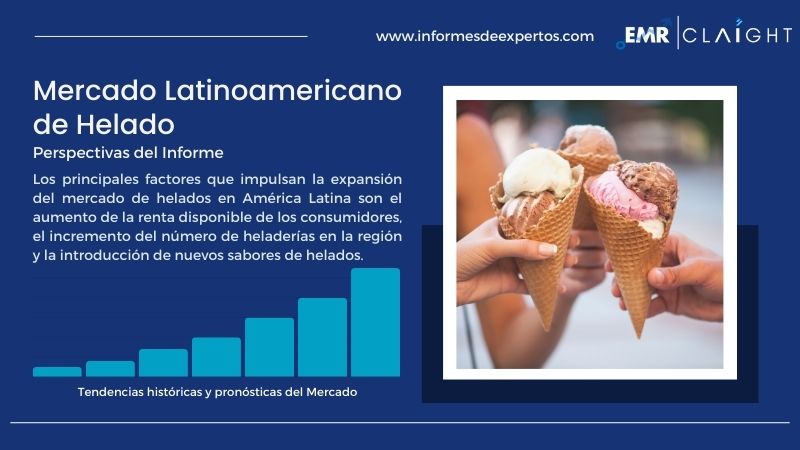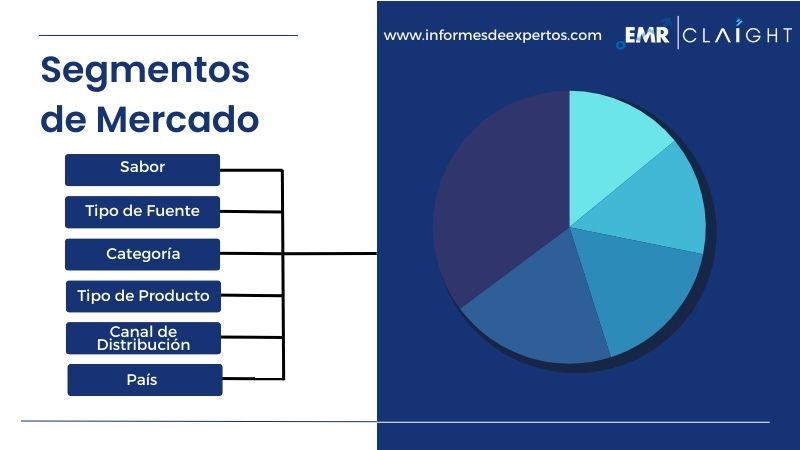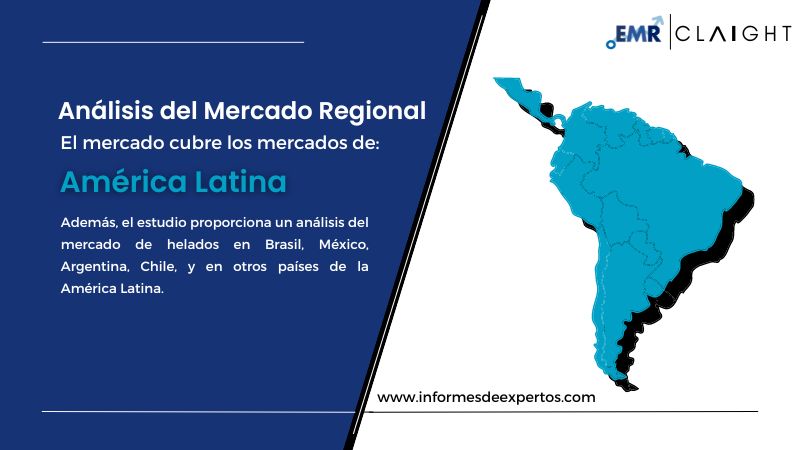Informes

Mercado Latinoamericano de Helado, Tamaño, Cuota, Análisis – Por Sabor (Chocolate, Fruta, Vainilla, Otros); Por Tipo de Fuente (Lácteo, Vegano); Por Categoría (Impulso, Para Llevar, Artesanal); Por Tipo de Producto (Taza, Palo, Cono, Bloque, Tina, Otros); Por Canal de Distribución (Supermercados e Hipermercados, Tiendas de Conveniencia, Heladerías, Tiendas en Línea, Otros); Por País (Brasil, México, Argentina, Chile, Otros); Dinámica del Mercado y Panorama Competitivo
Perspectiva del Mercado Latinoamericano del Helado
El mercado latinoamericano del helado alcanzó un valor de alrededor de USD 4,252.82 millones en 2025. Se prevé que el mercado crezca a una tasa de crecimiento anual compuesta del 2,8% entre 2026 y 2035, para alcanzar un valor de 5,452.74 millones de USD en 2035.
El helado es un postre dulce congelado que generalmente se prepara a partir de productos lácteos como la leche y la crema, que también incluye frutas, edulcorantes y sabores artificiales o naturales. Es una rica fuente de calcio, carbohidratos, riboflavina y vitaminas como A, C, D, E, K, B-6 y B-12. Ofrece varios beneficios para la salud, como fortalecer los huesos, proporcionar energía, reducir la presión arterial, estimular las funciones cerebrales y reparar el tejido muscular.

Informe de muestra gratuito con índice: Obtenga un informe de muestra gratuito con tabla de contenido
El creciente consumo de helados en el mundo ha cambiado drásticamente las tendencias de helados. La creciente utilización de helados en la elaboración de postres y bebidas, como tartas, batidos, wafles y café frío, está impulsando el mercado de helados en América Latina. Además, el crecimiento significativo de la industria láctea y la creciente demanda de alimentos preparados, junto con la disponibilidad de varios helados de sabores, también contribuyen al crecimiento de la industria de helados.
Además, el aumento de los ingresos disponibles y la mejora del poder adquisitivo de los consumidores están aumentando aún más el consumo per cápita del producto en la región. Aparte de esto, con el aumento de las tendencias de salud y bienestar, existe una creciente inclinación de los consumidores hacia los productos saludables. Esto ha llevado a una mayor demanda de nuevas variantes de productos como orgánicos, bajos en grasas, sin lactosa, sin gluten, y otros. Por lo tanto, las empresas de helados están invirtiendo cada vez más en la innovación y la diversificación de productos, lo que a su vez contribuirá a la expansión de la industria de helados
Entre los diversos países latinoamericanos, el mercado de helados en Chile es la más grande. Se nota el mayor consumo de helados en Chile, seguido por Costa Rica. Esto también esta ayudado por el creciente desarrollo de diferentes sabores de helados en Chile. Además, se espera que la tendencia emergente de productos híbridos, es decir, helados en combinación con pasteles, galletas, y malvaviscos, vigorice aún más el crecimiento del mercado del helado en los próximos años.

Informe de muestra gratuito con índice: Obtenga un informe de muestra gratuito con tabla de contenido
Helado: Segmentación del Mercado
Sobre la base del sabor, la industria se puede dividir en:
- Fruta
- Vainilla
- Otros
En la base de tipo de fuente, el mercado objetivo se clasifica entre:
- Helados Lácteos
- Helados Veganos
Por la categoría, el mercado se puede clasificar en términos generales en:
- Impulso
- Llevar a casa
- Artesanal
Los principales tipos de productos en el mercado de helados son:
- Taza
- Palo
- Cono
- Ladrillo
- Tina
- Otros
Por la base del canal de distribución, la industria se segmenta en:
- Supermercados e Hipermercados
- Tiendas de Conveniencia
- Heladerías
- Tiendas en Línea
- Otros
Además, el estudio proporciona un análisis del mercado de helados en Brasil, México, Argentina, Chile, y en otros países de la América Latina.

Informe de muestra gratuito con índice: Obtenga un informe de muestra gratuito con tabla de contenido
El creciente desarrollo de nuevas variantes de productos aumenta las oportunidades de crecimiento del mercado latinoamericano de helados
Se espera que el mercado de helados en América Latina registre un fuerte crecimiento en los próximos años debido a la creciente adopción de helados en la preparación de postres y bebidas, como tartas, batidos, gofres, helados y café frío. Además, el aumento de los ingresos disponibles de los consumidores, los cambios en los hábitos alimentarios y la mejora del poder adquisitivo de los consumidores están incrementando el consumo del producto. Según informes de la industria, se consumen alrededor de 7 kilos de helado per cápita al año en Argentina.
Además, los principales actores del mercado están ampliando su cartera de productos mediante la introducción de nuevas variantes, como productos ecológicos, bajos en grasa, sin lactosa, sin gluten, etcétera. Se prevé que esto atraiga a un mayor número de consumidores. Además, el aumento de la demanda de alimentos precocinados y la disponibilidad de helados de distintos sabores son otros factores que impulsan el crecimiento del mercado.
Actores Clave del Mercado Latinoamericano del Helado
Algunos de los principales actores mundiales son Sorvetes Jundiá Indústria E Comércio LTDA, Grupo Arcor , Unilever PLC, Froneri International Limited, Nestlé S.A., MontHelado S.A., Fábrica Heladería Grido, Freddo Franchising International, LLC., General Mills, Inc. y Ben & Jerry's Homemade, Inc. entre otros.
Las bases de datos incluidas en el informe sobre el mercado latinoamericano del helado proporcionan importantes impactos en el desarrollo presentadas por las principales empresas, teniendo en cuenta sus ingresos y niveles de volumen comercial de importación y exportación. Este informe consta de los valores del período histórico (2019-2025) y del período de pronóstico (2026-2035) con patrones de evaluación ampliados que se llevan a cabo mediante el análisis IDE basado en sabor, tipo de fuente, categoría, tipos de producto, canal de distribución y país del mercado para determinar el movimiento del estudio.
Además, el proyecto estudiado y analizado se basa en información detallada sobre el modelo de las cinco fuerzas de Porter, las estrategias de los principales actores existentes y sus carteras con diferenciación beneficiosa en innovación de productos en la industria. Por lo tanto, se concluye que el análisis del poder de negociación de los compradores, el poder adquisitivo de los consumidores, la amenaza de los sustitutos y la nueva entrada con el efecto de la reactivación económica y el desarrollo se evalúa para subrayar el poderoso impacto en el mercado.
Preguntas Clave Respondidas en Este Informe:
- ¿Cuál es el rendimiento actual y la trayectoria proyectada del mercado latinoamericano del helado?
- ¿Cuáles son los principales impulsores, oportunidades y retos para el mercado latinoamericano del helado?
- ¿Cómo afecta cada impulsor, restricción y oportunidad al mercado latinoamericano del helado?
- ¿Cuáles son los principales mercados regionales estudiados en el informe?
- ¿Cuál es la región líder en el mercado latinoamericano del helado?
- ¿Qué factores contribuyen al dominio de esta región en el mercado latinoamericano del helado?
- ¿Cuál es la tasa de crecimiento histórica del mercado latinoamericano del helado en los últimos años?
- ¿Cuáles son sus respectivas fortalezas y enfoques de mercado?
- ¿Cómo contribuyen estas empresas a la dinámica general del mercado latinoamericano del helado?
- ¿Cuál es la estructura competitiva del mercado?
- ¿Quiénes son los principales actores del mercado latinoamericano del helado?
Beneficios Clave para las Partes Interesadas:
- El informe de la industria de IDE ofrece un análisis cuantitativo exhaustivo de varios segmentos del mercado, las tendencias históricas y actuales del mercado, las previsiones del mercado y la dinámica del mercado latinoamericano del helado de 2019 a 2035.
- El informe ofrece los datos más recientes sobre los impulsores, retos y oportunidades del mercado. El informe traza los principales mercados regionales, así como los que registran la tasa de crecimiento más rápida. Además, permite a las partes interesadas identificar los principales mercados nacionales de cada región.
- El análisis de las cinco fuerzas de Porter ayuda a las partes interesadas a evaluar el impacto de los nuevos operadores, la rivalidad competitiva, el poder del proveedor, el poder del comprador y la amenaza de sustitución. Ayuda a las partes interesadas a analizar el nivel de competencia en la industria de latinoamericano del helado y su atractivo.
- El panorama competitivo permite a las partes interesadas comprender su entorno competitivo y ofrece una visión de las posiciones actuales de los principales actores del mercado.
Alcance del Mercado:
|
Características del Informe |
Detalles |
|
Año Base de la Estimación: |
2025 |
|
Datos Históricos: |
2019-2025 |
|
Datos de Pronóstico: |
2026-2035 |
|
Alcance del Informe: |
Tendencias Históricas y Previsiones del Mercado, Impulsores y Limitantes de
|
|
Desglose por Sabor: |
|
|
Desglose por |
|
|
Desglose por Categoría: |
|
|
Desglose por |
|
|
Desglose por |
|
|
Desglose por País: |
|
|
Dinámica del Mercado: |
|
|
Análisis de Datos Comerciales: |
|
|
Panorama Competitivo: |
|
|
Empresas Cubrietas: |
|
Informes de tendencias:
Mercado de Ropa Deportiva en México
Mercado de Ropa para Niños en Colombia
*En Informes de Expertos siempre nos esforzamos por brindarle la información más reciente. Los números de artículo son solo indicativos y pueden diferir del informe real.
Language of the Report – English
Sin embargo, el informe puede estar disponible en español por un costo adicional.
1 Preface
2 Report Coverage – Key Segmentation and Scope
3 Report Description
3.1 Market Definition and Outlook
3.2 Properties and Applications
3.3 Market Analysis
3.4 Key Players
4 Key Assumptions
5 Executive Summary
5.1 Overview
5.2 Key Drivers
5.3 Key Developments
5.4 Competitive Structure
5.5 Key Industrial Trends
6 Market Snapshot
7 Opportunities and Challenges in the Market
8 Latin America Ice Cream Market Overview
8.1 Key Industry Highlights
8.2 Latin America Ice Cream Historical Market (2019-2025)
8.3 Latin America Ice Cream Market Forecast (2026-2035)
9 Latin America Ice Cream Market by Flavour
9.1 Chocolate
9.1.1 Historical Trend (2019-2025)
9.1.2 Forecast Trend (2026-2035)
9.2 Fruit
9.2.1 Historical Trend (2019-2025)
9.2.2 Forecast Trend (2026-2035)
9.3 Vanilla
9.3.1 Historical Trend (2019-2025)
9.3.2 Forecast Trend (2026-2035)
9.4 Others
10 Latin America Ice Cream Market by Source Type
10.1 Dairy-based Ice Creams
10.1.1 Historical Trend (2019-2025)
10.1.2 Forecast Trend (2026-2035)
10.2 Vegan Ice Creams
10.2.1 Historical Trend (2019-2025)
10.2.2 Forecast Trend (2026-2035)
11 Latin America Ice Cream Market by Category
11.1 Impulse Ice Cream
11.1.1 Historical Trend (2019-2025)
11.1.2 Forecast Trend (2026-2035)
11.2 Take-Home Ice Cream
11.2.1 Historical Trend (2019-2025)
11.2.2 Forecast Trend (2026-2035)
11.3 Artisanal Ice Cream
11.3.1 Historical Trend (2019-2025)
11.3.2 Forecast Trend (2026-2035)
12 Latin America Ice Cream Market by Product Type
12.1 Cup
12.1.1 Historical Trend (2019-2025)
12.1.2 Forecast Trend (2026-2035)
12.2 Stick
12.2.1 Historical Trend (2019-2025)
12.2.2 Forecast Trend (2026-2035)
12.3 Cone
12.3.1 Historical Trend (2019-2025)
12.3.2 Forecast Trend (2026-2035)
12.4 Tub
12.4.1 Historical Trend (2019-2025)
12.4.2 Forecast Trend (2026-2035)
12.5 Brick
12.5.1 Historical Trend (2019-2025)
12.5.2 Forecast Trend (2026-2035)
12.6 Others
13 Latin America Ice Cream Market by Distribution Channel
13.1 Supermarkets and Hypermarkets
13.1.1 Historical Trend (2019-2025)
13.1.2 Forecast Trend (2026-2035)
13.2 Convenience Stores
13.2.1 Historical Trend (2019-2025)
13.2.2 Forecast Trend (2026-2035)
13.3 Ice Cream Parlours
13.3.1 Historical Trend (2019-2025)
13.3.2 Forecast Trend (2026-2035)
13.4 Online Stores
13.4.1 Historical Trend (2019-2025)
13.4.2 Forecast Trend (2026-2035)
13.5 Others
14 Latin America Ice Cream Market by Country
14.1 Brazil
14.1.1 Historical Trend (2019-2025)
14.1.2 Forecast Trend (2026-2035)
14.2 Mexico
14.2.1 Historical Trend (2019-2025)
14.2.2 Forecast Trend (2026-2035)
14.3 Argentina
14.3.1 Historical Trend (2019-2025)
14.3.2 Forecast Trend (2026-2035)
14.4 Chile
14.4.1 Historical Trend (2019-2025)
14.4.2 Forecast Trend (2026-2035)
14.5 Others
15 Market Dynamics
15.1 SWOT Analysis
15.1.1 Strengths
15.1.2 Weaknesses
15.1.3 Opportunities
15.1.4 Threats
15.2 Porter’s Five Forces Analysis
15.2.1 Supplier’s Power
15.2.2 Buyer’s Power
15.2.3 Threat of New Entrants
15.2.4 Degree of Rivalry
15.2.5 Threat of Substitutes
15.3 Key Indicators of Demand
15.4 Key Indicators of Price
16 Value Chain Analysis
17 Trade Data Analysis (Hs Code – 210500)
17.1 Major Importing Countries
17.1.1 By Volume
17.1.2 By Value
17.2 Major Exporting Countries
17.2.1 By Volume
17.2.2 By Value
18 Competitive Landscape
18.1 Market Structure
18.2 Company Profiles
18.2.1 Sorvetes Jundiá Indústria E Comércio LTDA
18.2.1.1 Company Overview
18.2.1.2 Product Portfolio
18.2.1.3 Demographic Reach and Achievements
18.2.1.4 Certifications
18.2.2 Grupo Arcor
18.2.2.1 Company Overview
18.2.2.2 Product Portfolio
18.2.2.3 Demographic Reach and Achievements
18.2.2.4 Certifications
18.2.3 Unilever PLC
18.2.3.1 Company Overview
18.2.3.2 Product Portfolio
18.2.3.3 Demographic Reach and Achievements
18.2.3.4 Certifications
18.2.4 Froneri International Limited
18.2.4.1 Company Overview
18.2.4.2 Product Portfolio
18.2.4.3 Demographic Reach and Achievements
18.2.4.4 Certifications
18.2.5 Nestlé S.A.
18.2.5.1 Company Overview
18.2.5.2 Product Portfolio
18.2.5.3 Demographic Reach and Achievements
18.2.5.4 Certifications
18.2.6 MontHelado S.A.
18.2.6.1 Company Overview
18.2.6.2 Product Portfolio
18.2.6.3 Demographic Reach and Achievements
18.2.6.4 Certifications
18.2.7 Fábrica Heladería Grido
18.2.7.1 Company Overview
18.2.7.2 Product Portfolio
18.2.7.3 Demographic Reach and Achievements
18.2.7.4 Certifications
18.2.8 Freddo Franchising International, LLC.
18.2.8.1 Company Overview
18.2.8.2 Product Portfolio
18.2.8.3 Demographic Reach and Achievements
18.2.8.4 Certifications
18.2.9 General Mills, Inc.
18.2.9.1 Company Overview
18.2.9.2 Product Portfolio
18.2.9.3 Demographic Reach and Achievements
18.2.9.4 Certifications
18.2.10 Ben & Jerry's Homemade, Inc.
18.2.10.1 Company Overview
18.2.10.2 Product Portfolio
18.2.10.3 Demographic Reach and Achievements
18.2.10.4 Certifications
18.2.11 Others
19 Key Trends and Developments in the Market
List of Key Figures and Tables
1. Latin America Ice Cream Market: Key Industry Highlights, 2019 and 2035
2. Latin America Ice Cream Historical Market: Breakup by Flavour (USD Million), 2019-2025
3. Latin America Ice Cream Market Forecast: Breakup by Flavour (USD Million), 2026-2035
4. Latin America Ice Cream Historical Market: Breakup by Source Type (USD Million), 2019-2025
5. Latin America Ice Cream Market Forecast: Breakup by Source Type (USD Million), 2026-2035
6. Latin America Ice Cream Historical Market: Breakup by Product Type (USD Million), 2019-2025
7. Latin America Ice Cream Market Forecast: Breakup by Product Type (USD Million), 2026-2035
8. Latin America Ice Cream Historical Market: Breakup by Category (USD Million), 2019-2025
9. Latin America Ice Cream Market Forecast: Breakup by Category (USD Million), 2026-2035
10. Latin America Ice Cream Historical Market: Breakup by Distribution Channel (USD Million), 2019-2025
11. Latin America Ice Cream Market Forecast: Breakup by Distribution Channel (USD Million), 2026-2035
12. Latin America Ice Cream Historical Market: Breakup by Country (USD Million), 2019-2025
13. Latin America Ice Cream Market Forecast: Breakup by Country (USD Million), 2026-2035
14. Major Importing Countries by Volume
15. Major Exporting Countries by Volume
16. Major Importing Countries by Value
17. Major Exporting Countries by Value
18. Latin America Ice Cream Market Structure
*The list of players in the competitive landscape section can be customised or made more exhaustive based on your specific requirements.*
¿Cuál fue el tamaño del mercado de helados en América Latina en 2025?
En 2025, el mercado objetivo alcanzó un valor de USD 4,252.82 millones.
¿Cuál es la tasa de crecimiento media estimada del mercado de helados en América Latina?
Se prevé que el mercado crezca a una CAGR del 2,8% en el periodo de pronóstico 2026-2035.
¿Qué factores afectan al mercado de helados en América Latina?
Los principales factores que impulsan la industria de helados son el aumento de los ingresos disponibles de los consumidores, el crecimiento de la industria láctea, la creciente demanda de alimentos preparados y las preferencias de los consumidores
¿Cómo puede clasificarse el mercado de los helados según el tipo?
El sector se puede clasificar en términos generales en función del tipo como taza, palo, cono, bloque, tina, otros.
¿Cómo se segmenta el mercado de los helados según el sabor?
El sector se puede clasificar en términos generales en función del sabor como chocolate, fruta, vainilla, y otros.
¿Cuáles son las categorías significativas de los helados?
Las categorías más importantes del producto son impulso, para llevar, artesanal.
¿Qué canales de distribución forman parte del mercado de helado?
Los canales de distribución más importantes del producto son supermercados e hipermercados, tiendas de conveniencia, heladerías, tiendas en línea, otros.
¿Qué empresas lideran el mercado de helados en América Latina?
Los principales actores en el mercado de helados son Sorvetes Jundiá Indústria E Comércio LTDA, Grupo Arcor, Unilever PLC, Froneri International Limited, Nestlé S.A., MontHelado S.A., Fábrica Heladería Grido, Freddo Franchising International, LLC., General Mills, Inc., Ben & Jerry's Homemade, Inc., y otros.
¿Qué regiones de América Latina tienen mayor influencia en la industria de helados?
El informe proporcione información sobre las principales regiones de la industria, que son Brasil, Chile, México, Argentina, y otros.
¿Influyó la pandemia en el crecimiento y la demanda de la industria de helados?
La pandemia tuvo una influencia negativa sobre la demanda de helados por el cierre de industrias y la reducción de la venta y el consumo de los helados debido a las directivas del gobierno.
¿Cuál es la perspectiva de pronóstico del mercado latinoamericano del helado para 2026-2035?
Se estima que el mercado latinoamericano del helado registrará un fuerte crecimiento durante el periodo de pronóstico de 2026-2035 para alcanzar los 5,452.74 millones de USD en 2035.
Excel Data Set
USD1799
-
Datos completos en formato Excel para un usuario
-
Impresión no permitida
-
Entrega por Email
-
Personalización limitada gratuita (pre-venta)Soporte de analista post ventaDescuento del 50% en la Próxima ActualizaciónUsuario Único
USD3199
USD2999-
Restringido a un usuario
-
Solo una impresión
-
Disponible en PDF
-
Personalización limitada gratuita (pre-venta)Soporte de analista post ventaDescuento del 50% en la Próxima ActualizaciónCinco Usuarios
USD4199
USD3999-
Restringido a cinco usuarios
-
Una impresión por usuario
-
Disponible en PDF
-
Personalización limitada gratuita (pre-venta)
-
Soporte de analista post venta
-
Descuento del 50% en la Próxima Actualización
Multiusuario
USD5199
USD4999-
Usuarios ilimitados dentro de la organización
-
Impresiones ilimitadas
-
Disponible en PDF
-
Personalización limitada gratuita (pre-venta)
-
Soporte de analista post venta
-
Descuento del 50% en la Próxima Actualización
Póngase en Contacto¿Cualquier Pregunta? Hable con un Analista
Solicitar una MuestraVer una Muestra
Solicitar PersonalizaciónSe le olvidó algo? Pregunte Ahora
¿Por qué Informes de Expertos?La Gente Adecuada
Somos técnicamente excelentes, estratégicos, prácticos, experimentados y eficientes; nuestros analistas son cuidadosamente seleccionados en función de tener los atributos correctos para trabajar con éxito y ejecutar proyectos basados en sus expectativas.
Metodología Correcta
Aprovechamos nuestra tecnología de vanguardia, nuestro acceso a bases de datos confiables y nuestro conocimiento de los modelos actuales utilizados en el mercado para ofrecerle soluciones de investigación que se adapten a sus necesidades y lo pongan a la vanguardia.
Precio Justo
Realizamos una investigación exhaustiva y de calidad superior a precios razonables, inigualables y que demuestran nuestra comprensión de su estructura de recursos. Además, ofrecemos descuentos atractivos en nuestros próximos informes.
Apoyo Adecuado
Nuestro equipo de analistas expertos está a su disposición entera para ofrecerle resultados óptimos personalizados para satisfacer sus necesidades precisas dentro del plazo especificado y ayudarlo a comprender mejor la industria.
Informes SimilaresEl mercado de carne congelada en México alcanzó un valor de 5,74 millones de USD en 2025 y, con una tasa compuesta de crecimiento anual del 10,6%, alcanzará un valor de 15,71 millones de USD en 203...
El mercado mundial de sopas instantáneas está experimentando un crecimiento considerable por el aumento de los ingresos disponibles, los cambios en los hábitos alimentarios de los consumidores, la ...
El crecimiento del mercado de sopas instantáneas en México está aumentando debido a la expansión de los canales de distribución, la creciente demanda de sopas elaboradas con ingredientes naturale...
El crecimiento del mercado de sopas instantáneas en Perú está impulsado por la creciente preferencia por los productos de conveniencia, el aumento de los ingresos disponibles, la expansión de los ...
El crecimiento del mercado de alimentos congelados está impulsado por los estilos de vida ajetreados de los consumidores, el aumento de los ingresos disponibles, la creciente demanda de alimentos de ...
Newsletter





